
Sentinel-2 satellite preview of Chennai-region, captured on 2025-10-31 from an altitude of approximately 786 km.
Statement of Problem
Rapid urbanization and climate change are placing unprecedented stress on cities worldwide. As built-up areas expand and green spaces decline, urban heat islands intensify, air quality deteriorates, and residents face increased health risks. Understanding the spatial distribution of vegetation and development is essential for evidence-based urban planning, climate adaptation, and public health protection. This analysis quantifies the current balance between green cover and built-up surfaces in Chennai-region, identifies thermal vulnerability hotspots, and provides actionable recommendations for enhancing urban forestry and green infrastructure.
1. Urban Forestry Assessment: Current Vegetation & Built-Up Status
1.1 Vegetation Distribution (NDVI Analysis)
The analysis of NDVI statistics for the Chennai region reveals a mean NDVI value of 0.212 and a median of 0.206, indicating a moderate level of vegetation cover across the region. The standard deviation of 0.201 suggests a significant variability in vegetation density. Spatially, the NDVI color and greyscale maps show that areas with higher NDVI values, indicating denser vegetation, are primarily located in the outskirts and certain green zones within the city. Conversely, lower NDVI values are observed in highly urbanized areas, reflecting less green cover. This distribution underscores the need for targeted urban forestry initiatives to enhance green cover in built-up zones.
1.2 Built-Up Intensity (NDBI Analysis)
The NDBI analysis for Chennai indicates a mean value of -0.055 and a median of -0.035, suggesting a relatively low level of built-up intensity across the region. However, the standard deviation of 0.099 points to significant variability, with certain areas exhibiting high built-up intensity. The NDBI maps highlight that the central and southern parts of Chennai have higher built-up densities, likely due to commercial and residential developments. These patterns imply increased development pressure in these zones, necessitating careful urban planning to balance growth with green space preservation.
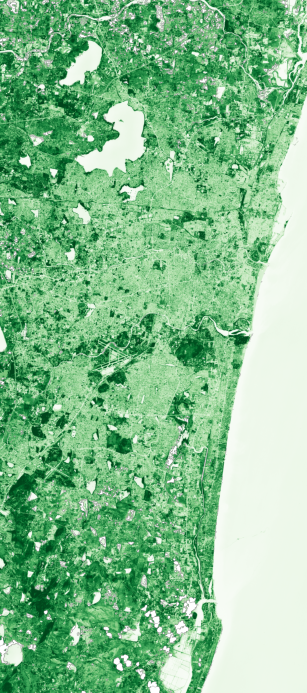
NDVI Color Visualization
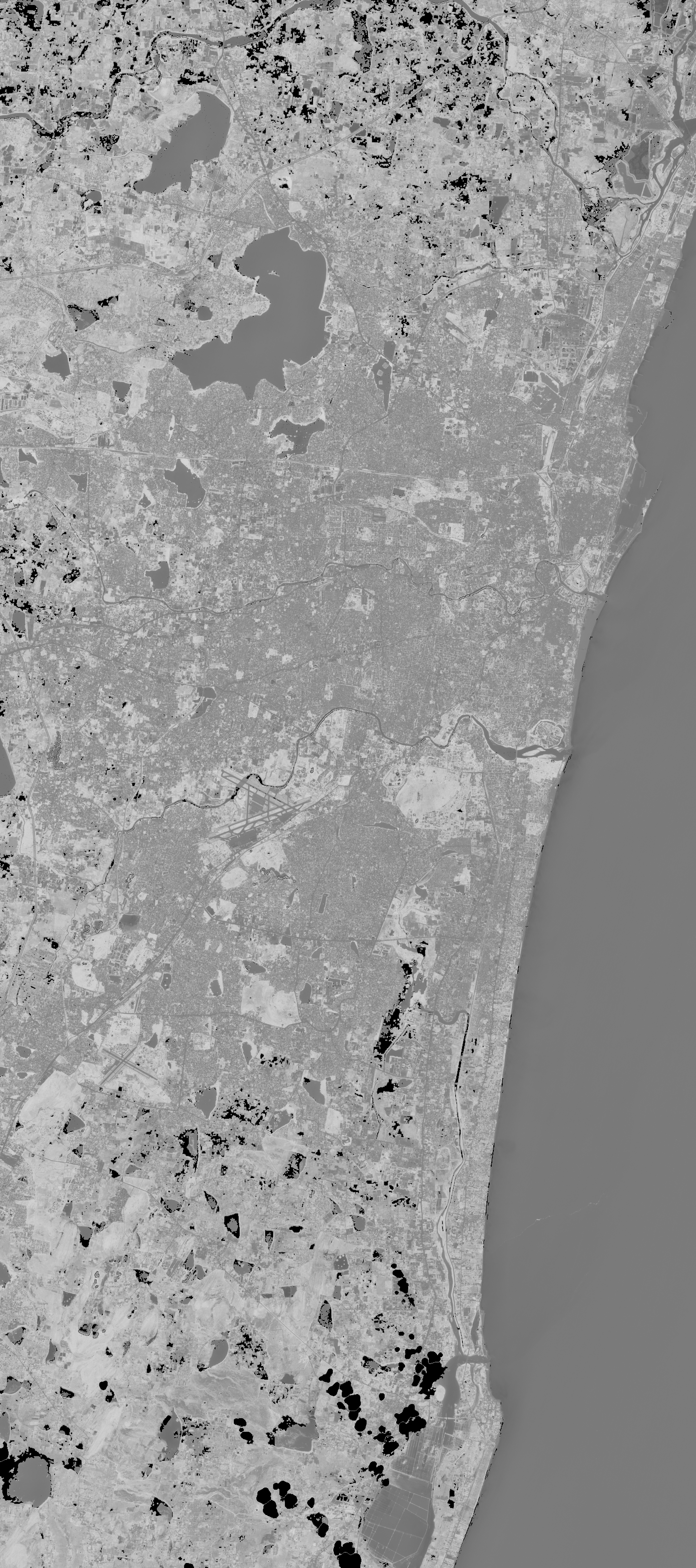
NDVI Greyscale (Index Values)
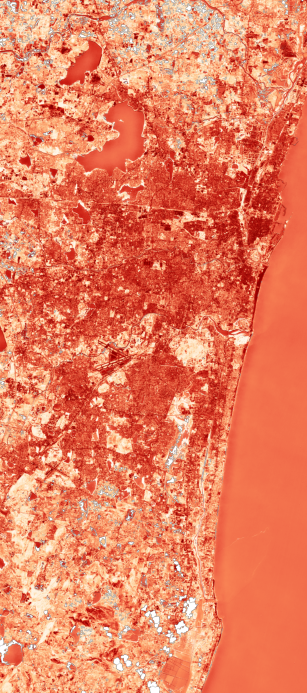
NDBI Color Visualization
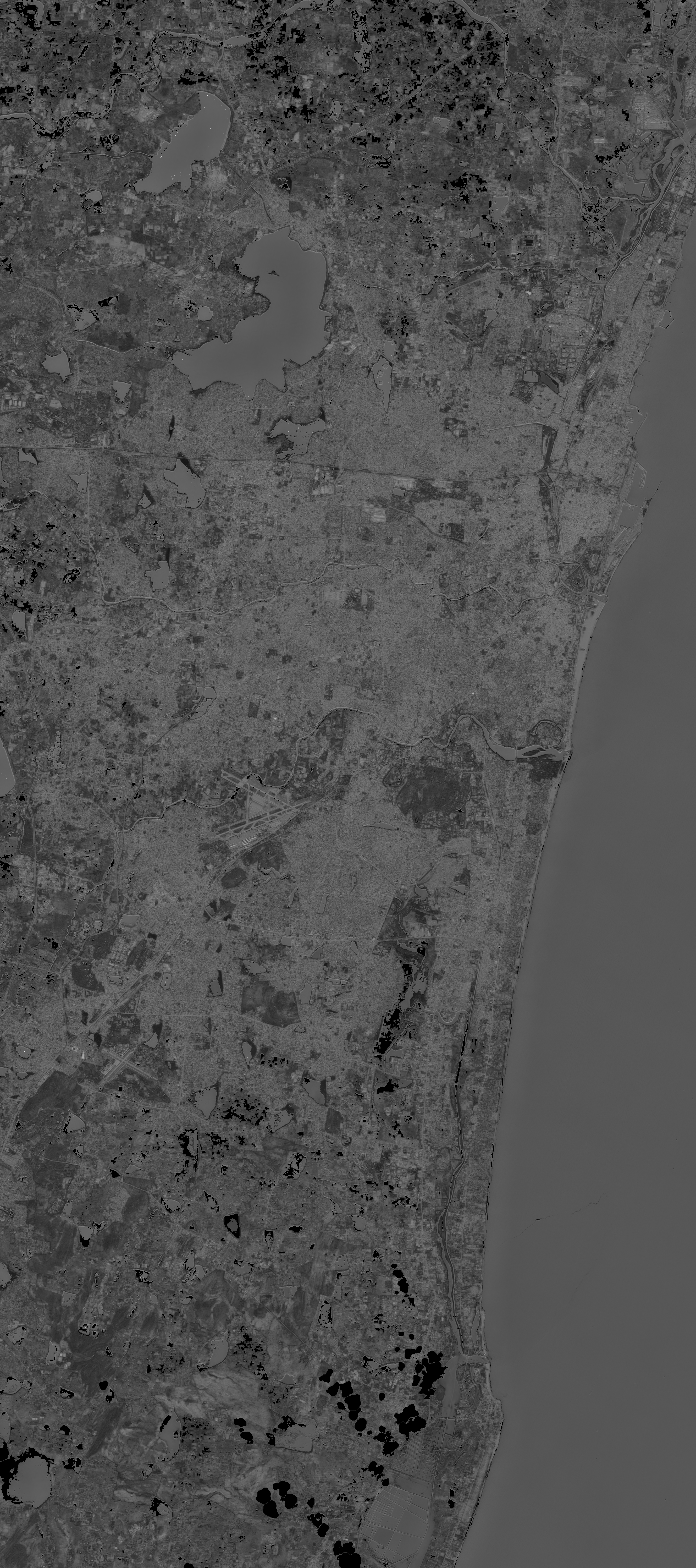
NDBI Greyscale (Index Values)
Additional Vegetation & Water Indices
Beyond NDVI and NDBI, three complementary indices provide deeper insights into vegetation health and water presence:
EVI (Enhanced Vegetation Index)
EVI improves on NDVI by correcting for atmospheric conditions and canopy background noise. It is more sensitive in areas with dense vegetation, making it useful for monitoring forest health and identifying vegetation stress that NDVI might miss.
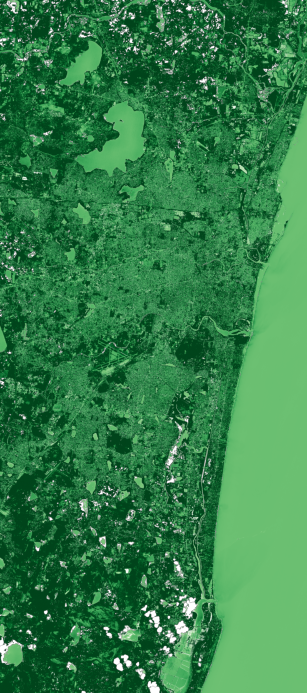
EVI Color Visualization
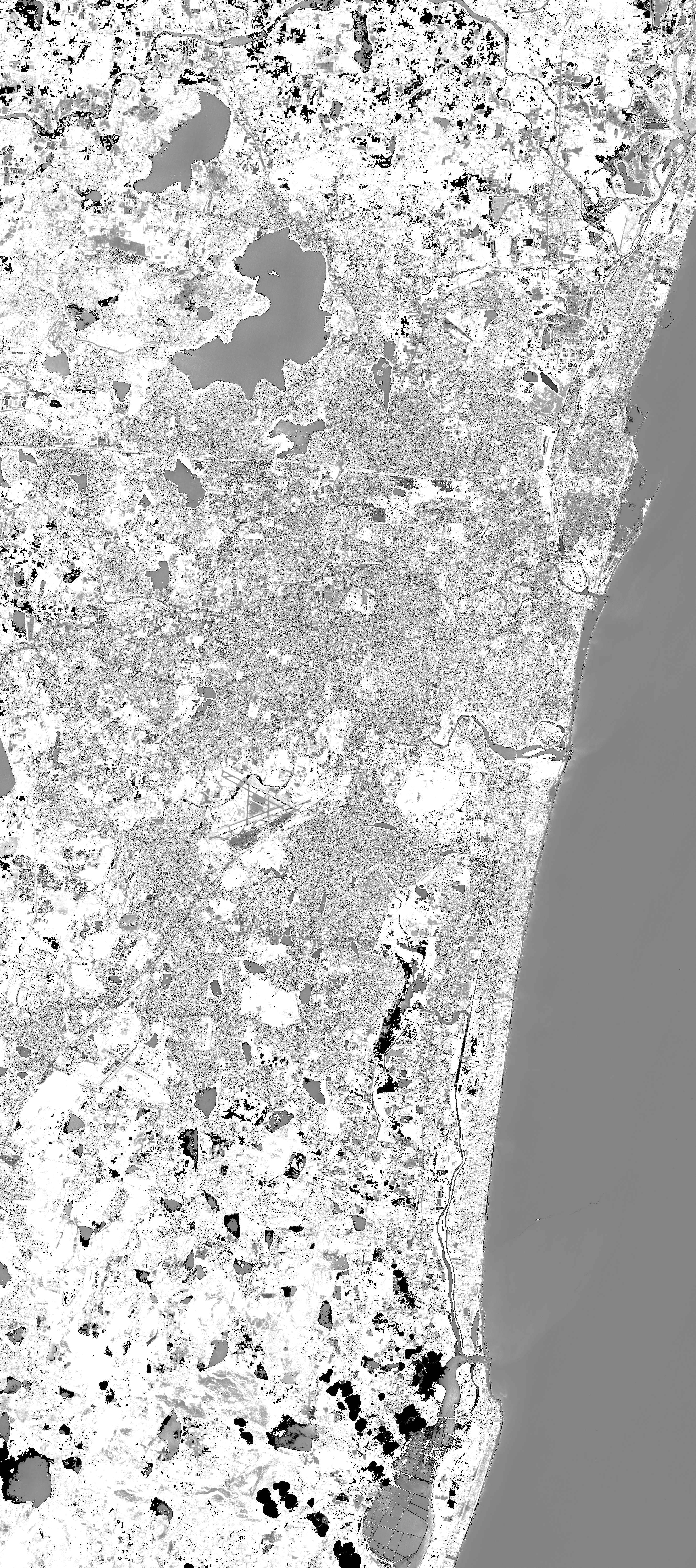
EVI Greyscale (Index Values)
MNDWI (Modified Normalized Difference Water Index)
MNDWI enhances water body detection by using green and shortwave infrared bands. It is more effective than NDWI at separating water features from built-up areas, making it ideal for mapping urban water bodies like lakes, rivers, and reservoirs.
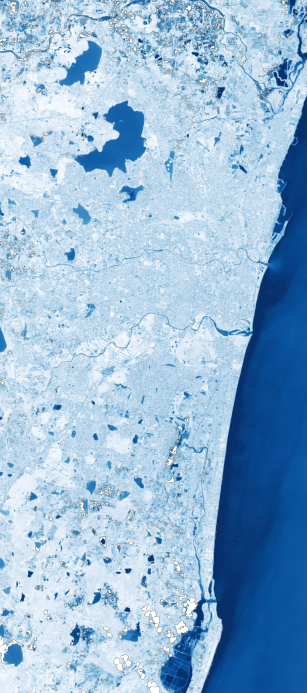
MNDWI Color Visualization
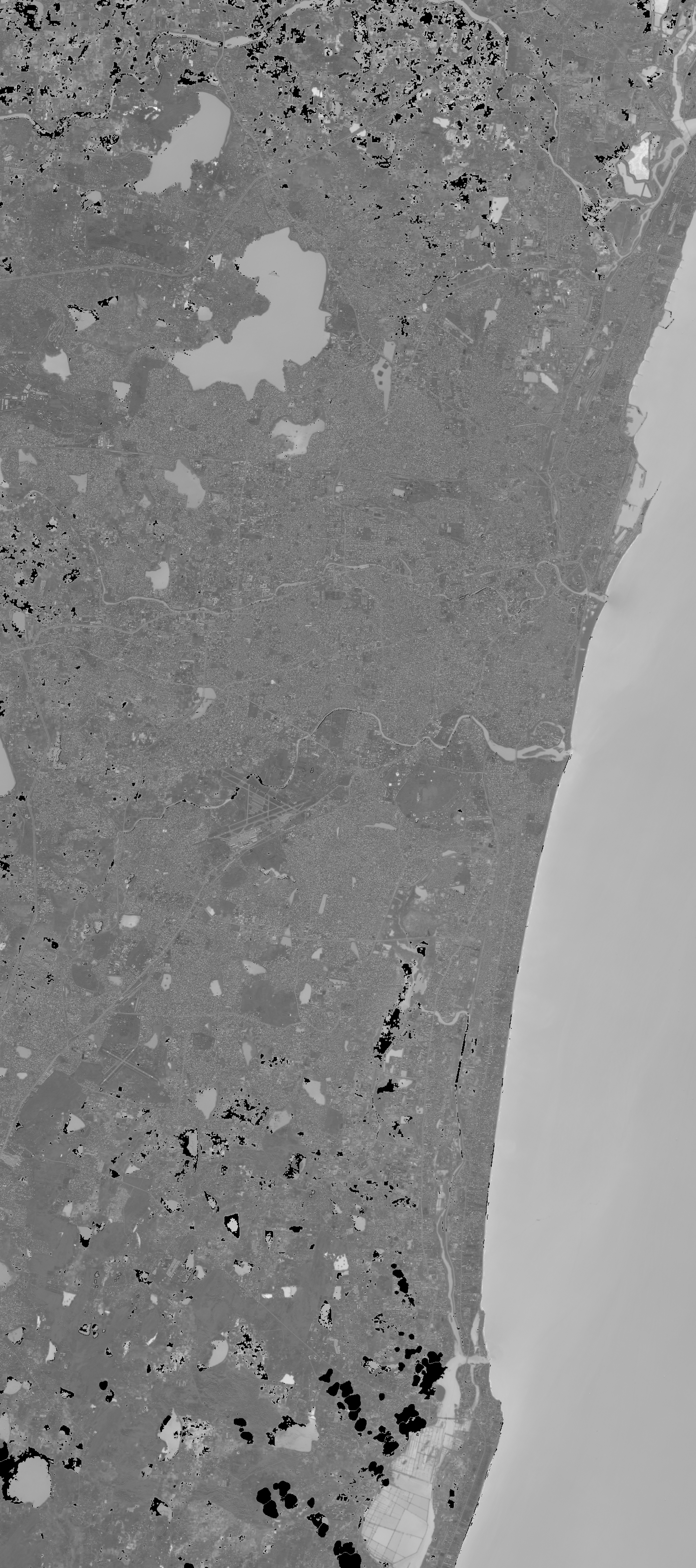
MNDWI Greyscale (Index Values)
NDMI (Normalized Difference Moisture Index)
NDMI measures vegetation water content by comparing near-infrared and shortwave infrared reflectance. Higher values indicate well-hydrated vegetation, while lower values suggest drought stress. This index is valuable for assessing irrigation effectiveness and identifying areas at risk of vegetation die-off.
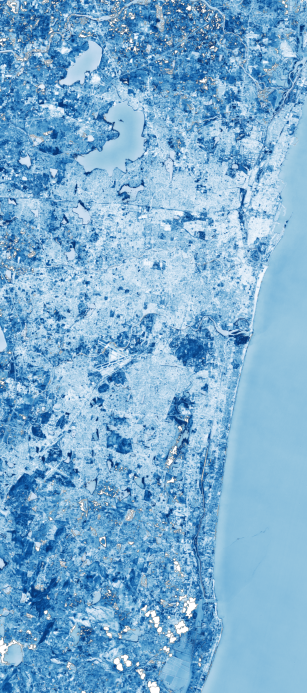
NDMI Color Visualization
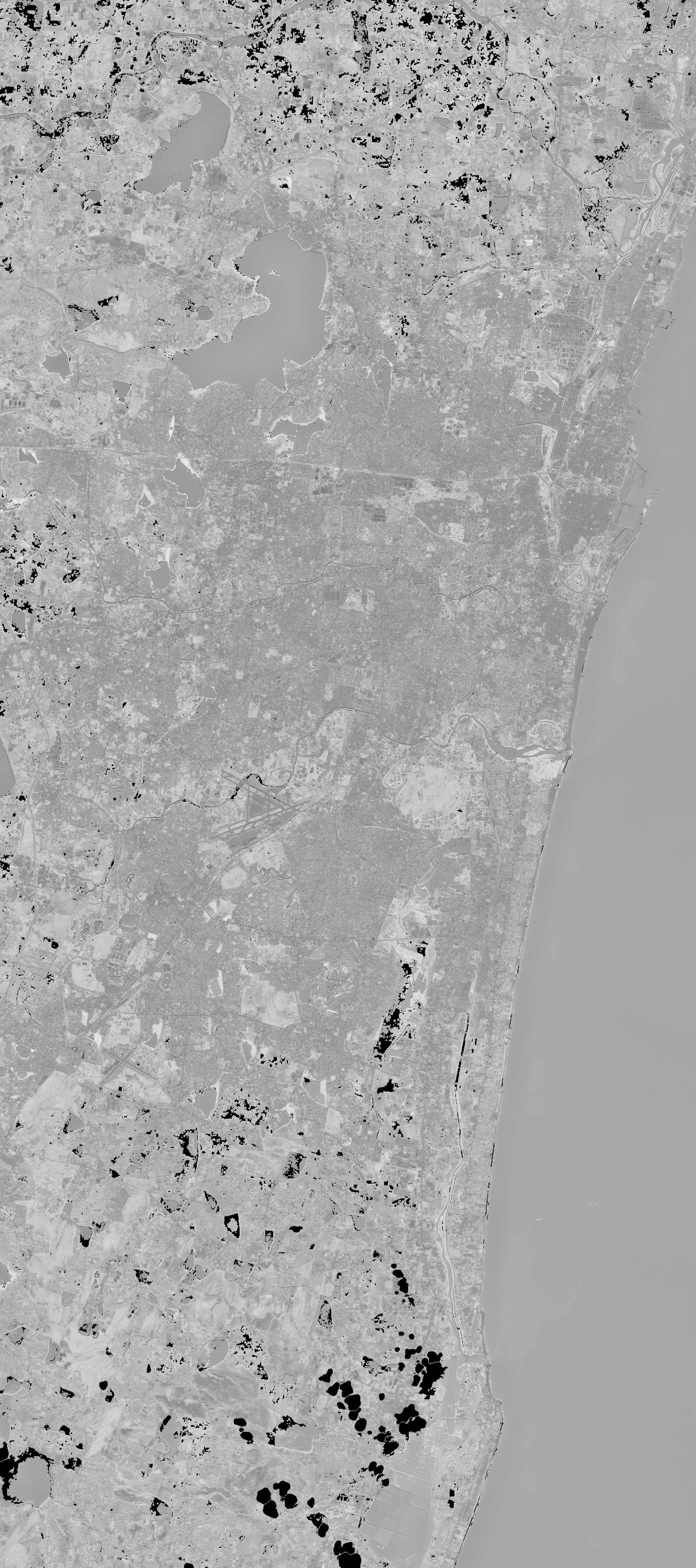
NDMI Greyscale (Index Values)
2. Vegetation-Development Balance Analysis
2.1 NDVI-NDBI Difference Analysis
The NDVI-NDBI difference analysis provides insights into the balance between vegetation and built-up areas in Chennai. The majority of the region (76.05%) falls within the bin range of -0.054 to 0.594, indicating a moderate balance where neither vegetation nor built-up areas dominate significantly. However, 17.88% of the region shows a strong positive difference (0.594 to 1.243), suggesting areas where vegetation dominates, likely green parks and natural reserves. Conversely, a small percentage (0.0018%) shows a strong negative difference (-2.0 to -1.351), indicating highly urbanized zones with minimal vegetation. The difference map and legend help visualize these patterns, with warmer colors representing vegetation dominance and cooler colors indicating built-up dominance. This analysis highlights the spatial heterogeneity in Chennai's urban landscape and the need for targeted interventions to enhance green cover in built-up areas.
2.2 Overlay Interpretation
The combined overlay image of NDVI and NDBI for Chennai reveals distinct patterns when viewed together. Areas with high NDVI values (green zones) are clearly distinguishable from areas with high NDBI values (urban zones). This overlay helps identify regions where vegetation and built-up areas coexist, as well as zones where one dominates over the other. Such insights are crucial for urban planners to develop strategies that promote green infrastructure within urban settings.
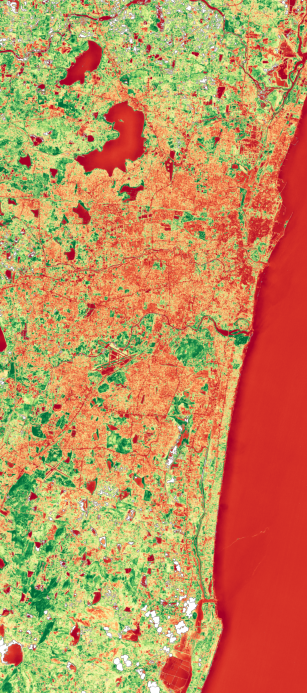
NDVI-NDBI Difference Map (Green = vegetation-dominated; Red = built-up-dominated)
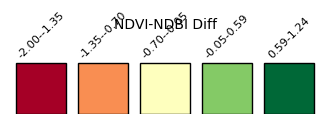
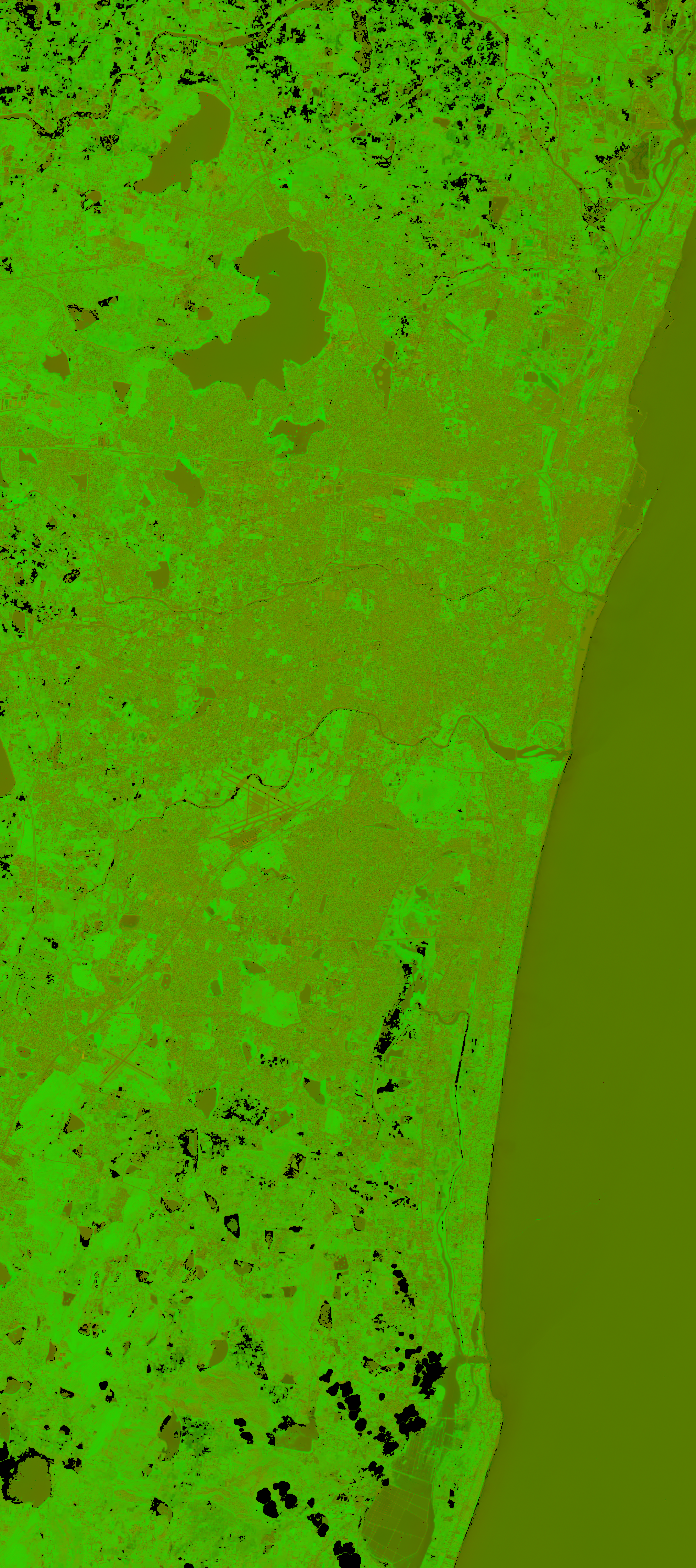
Combined NDVI-NDBI Overlay
3. Urban Heat Island Risk & Thermal Vulnerability
3.1 Heat Risk Distribution
The heat risk distribution in Chennai, as indicated by the Urban Heat Index bins, shows that 76.05% of the region falls within the moderate heat risk zone (-0.594 to 0.054), suggesting a balanced thermal environment in most areas. However, 15.65% of the region is classified as high-risk (-1.243 to -0.594), primarily in densely built-up areas with minimal vegetation. These high-risk zones are susceptible to the urban heat island effect, posing significant public health risks. The heat index map and legend further illustrate these spatial patterns, with warmer colors indicating higher heat risk. Addressing these high-risk zones through green infrastructure projects is essential to mitigate heat-related health issues and improve overall urban livability.
3.2 Key Findings & Implications
- Total green cover percentage: 36.98%
- Healthy vegetation percentage: 8.9%
- Vegetation health score: 0.434
- Green infrastructure score: 0.523
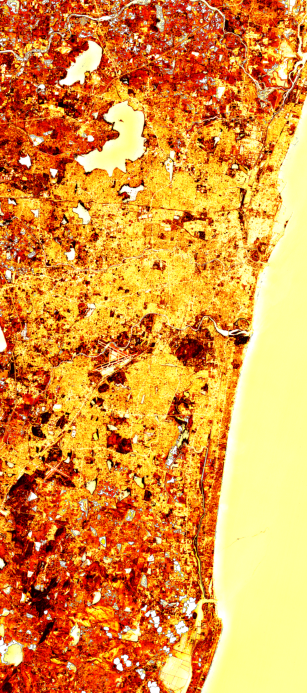
Urban Heat Index Map (Red = high risk zones)
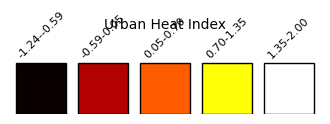
4. Strategic Recommendations for Green Infrastructure
4.1 What's Working Well
- The presence of significant green cover (36.98%) indicates successful urban forestry efforts in certain areas of Chennai.
- The moderate heat risk distribution in 76.05% of the region suggests effective thermal management in most areas.
4.2 Critical Challenges
- The low percentage of healthy vegetation (8.9%) highlights the need for improved vegetation management practices.
- High-risk heat zones (15.65%) without adequate vegetation coverage require immediate attention to mitigate urban heat island effects.
4.3 Evidence-Based Recommendations
- Implement targeted greening projects in high-risk heat zones to reduce urban heat island effects and improve public health.
- Enhance vegetation health through regular maintenance and introduction of drought-resistant species to increase the healthy vegetation percentage.
- Develop policies that incentivize green infrastructure in new urban developments to maintain and improve the green infrastructure score.
Analysis Coverage Area
The interactive map below shows the exact geographical bounds of this satellite analysis. The colored overlay represents the NDVI coverage area overlaid on OpenStreetMap. You can zoom and pan to explore how the analysis boundaries align with streets, neighborhoods, and landmarks in Chennai-region.
Interactive map: Use mouse/touch to zoom and pan. The overlay shows the satellite image bounds used for NDVI/NDBI calculations.
Note: The analysis boundaries may extend beyond administrative city limits as they represent the satellite image crop captured on 2025-10-31. This ensures complete coverage of the urban area and surrounding regions for comprehensive vegetation and heat risk assessment.
Why Urban Green Cover Matters
Urban forests and green spaces are critical infrastructure for healthy, livable cities. Trees and vegetation reduce air pollution, lower urban temperatures through shade and evapotranspiration, manage stormwater, support biodiversity, and improve mental health and well-being. As cities grow denser and climate change intensifies heat events, monitoring and protecting urban green cover becomes essential for public health and environmental resilience.
Satellite remote sensing provides objective, repeatable measurements of vegetation health and urban development patterns across entire metropolitan areas. The Normalized Difference Vegetation Index (NDVI) quantifies photosynthetic activity and green cover, while the Normalized Difference Built-up Index (NDBI) identifies impervious surfaces and development intensity. Together, these indices reveal the changing balance between nature and urban growth—and highlight where intervention is most needed.
Understanding NDVI and NDBI
NDVI (Normalized Difference Vegetation Index) measures the difference between near-infrared light (strongly reflected by healthy vegetation) and red light (absorbed by chlorophyll). Values range from -1 to +1, with higher values indicating denser, healthier vegetation. Typical ranges: 0.6-0.9 = dense forest; 0.3-0.6 = moderate vegetation; 0.1-0.3 = sparse vegetation; <0.1 = bare soil or built-up areas.
NDBI (Normalized Difference Built-up Index) uses shortwave infrared and near-infrared bands to identify constructed surfaces. Positive values indicate built-up areas (roads, buildings, concrete), while negative values suggest natural or vegetated land. When NDBI exceeds NDVI in an area, it signals high development intensity and elevated urban heat island risk.
Data & Methods
Data Sources
- Satellite: Sentinel-2B Level-2A (atmospherically corrected)
- Provider: Microsoft Planetary Computer
- Observation Date: 2025-10-31
- Cloud Cover: 0.93429%
- Spatial Resolution: 10 meters (NDVI), 20 meters (NDBI, resampled to 10m)
Index Calculations
- NDVI = (NIR - Red) / (NIR + Red) using Bands 8 and 4
- NDBI = (SWIR1 - NIR) / (SWIR1 + NIR) using Bands 11 and 8
- Difference Index = NDVI - NDBI (positive = vegetation-dominated; negative = built-up-dominated)
- Urban Heat Index = Composite metric flagging areas where NDBI > NDVI (high heat risk)
Processing Workflow
Images were processed using Python with the pystac-client and rasterio
libraries. Cloud masking was applied using the QA60 scene classification layer. Statistics
were computed using rasterio zonal statistics and exported as JSON for
analysis. All geospatial outputs are provided as Cloud-Optimized GeoTIFFs (COGs) for
efficient web access and GIS integration.
Limitations
- Analysis represents a single-day snapshot; seasonal and temporal trends require time-series analysis
- Cloud cover and atmospheric conditions affect image quality
- 10-meter resolution may not capture individual trees or small green spaces
- Study area boundaries reflect the satellite image crop, not administrative city limits
- Heat risk is inferred from spectral indices; ground validation recommended for mitigation planning
Download Data & Maps
Images & Visualizations
- NDVI Color Map (PNG)
- NDBI Color Map (PNG)
- NDVI-NDBI Difference Map (PNG)
- Difference Map Legend (PNG)
- Urban Heat Index Map (PNG)
- Heat Index Legend (PNG)
- Combined Overlay (PNG)
- EVI Color Map (PNG)
- MNDWI Color Map (PNG)
- NDMI Color Map (PNG)
Geospatial Data (Cloud-Optimized GeoTIFFs)
- NDVI GeoTIFF (COG)
- NDBI GeoTIFF (COG)
- Difference GeoTIFF (COG)
- Heat Index GeoTIFF (COG)
- EVI GeoTIFF (COG)
- MNDWI GeoTIFF (COG)
- NDMI GeoTIFF (COG)
Statistical Data
How to Cite This Analysis
Recommended Citation
Yaragarla, R. (2025). Urban Green Cover & Heat Risk Assessment: Chennai-region. I Hug Trees. Retrieved from https://ihugtrees.org/data-analytics/sentinel-ndvi/Chennai-region/2025/11/25/digest.html
Satellite data: Copernicus Sentinel-2 (ESA), processed via Microsoft Planetary Computer.
BibTeX Entry
@misc{ihugtrees_urban_chennai-region_2025,
author = {Yaragarla, Ramkumar},
title = {Urban Green Cover \& Heat Risk Assessment: Chennai-region},
year = {2025},
publisher = {I Hug Trees},
url = {https://ihugtrees.org/data-analytics/sentinel-ndvi/Chennai-region/2025/11/25/digest.html},
note = {Satellite data: Copernicus Sentinel-2}
}
License
This analysis and associated datasets are licensed under Creative Commons Attribution 4.0 International (CC BY 4.0). You are free to share and adapt this work with appropriate attribution.
Planetary Computer Citation
If using Microsoft Planetary Computer data, please cite: microsoft/PlanetaryComputer (2022)